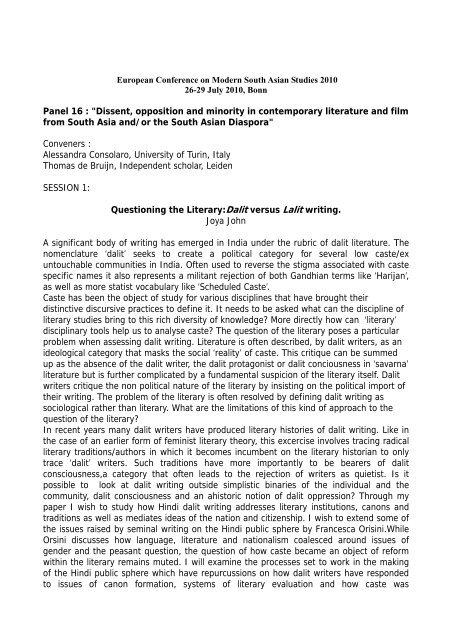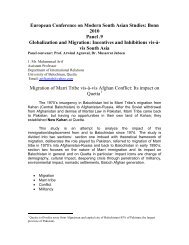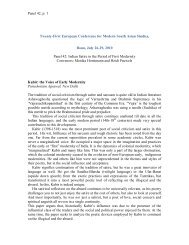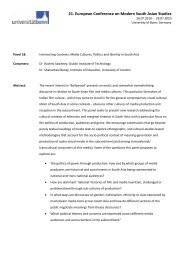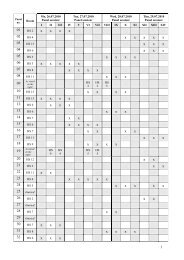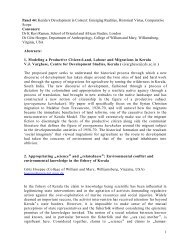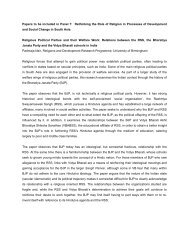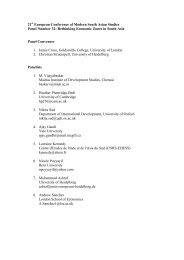European Conference on Modern South Asian Studies 2010
European Conference on Modern South Asian Studies 2010
European Conference on Modern South Asian Studies 2010
You also want an ePaper? Increase the reach of your titles
YUMPU automatically turns print PDFs into web optimized ePapers that Google loves.
<str<strong>on</strong>g>European</str<strong>on</strong>g> <str<strong>on</strong>g>C<strong>on</strong>ference</str<strong>on</strong>g> <strong>on</strong> <strong>Modern</strong> <strong>South</strong> <strong>Asian</strong> <strong>Studies</strong> <strong>2010</strong><br />
26-29 July <strong>2010</strong>, B<strong>on</strong>n<br />
Panel 16 : "Dissent, oppositi<strong>on</strong> and minority in c<strong>on</strong>temporary literature and film<br />
from <strong>South</strong> Asia and/or the <strong>South</strong> <strong>Asian</strong> Diaspora"<br />
C<strong>on</strong>veners :<br />
Alessandra C<strong>on</strong>solaro, University of Turin, Italy<br />
Thomas de Bruijn, Independent scholar, Leiden<br />
SESSION 1:<br />
Questi<strong>on</strong>ing the Literary:Dalit versus Lalit writing.<br />
Joya John<br />
A significant body of writing has emerged in India under the rubric of dalit literature. The<br />
nomenclature ‘dalit’ seeks to create a political category for several low caste/ex<br />
untouchable communities in India. Often used to reverse the stigma associated with caste<br />
specific names it also represents a militant rejecti<strong>on</strong> of both Gandhian terms like ‘Harijan’,<br />
as well as more statist vocabulary like ‘Scheduled Caste’.<br />
Caste has been the object of study for various disciplines that have brought their<br />
distinctive discursive practices to define it. It needs to be asked what can the discipline of<br />
literary studies bring to this rich diversity of knowledge? More directly how can ‘literary’<br />
disciplinary tools help us to analyse caste? The questi<strong>on</strong> of the literary poses a particular<br />
problem when assessing dalit writing. Literature is often described, by dalit writers, as an<br />
ideological category that masks the social ‘reality’ of caste. This critique can be summed<br />
up as the absence of the dalit writer, the dalit protag<strong>on</strong>ist or dalit c<strong>on</strong>ciousness in ‘savarna’<br />
literature but is further complicated by a fundamental suspici<strong>on</strong> of the literary itself. Dalit<br />
writers critique the n<strong>on</strong> political nature of the literary by insisting <strong>on</strong> the political import of<br />
their writing. The problem of the literary is often resolved by defining dalit writing as<br />
sociological rather than literary. What are the limitati<strong>on</strong>s of this kind of approach to the<br />
questi<strong>on</strong> of the literary?<br />
In recent years many dalit writers have produced literary histories of dalit writing. Like in<br />
the case of an earlier form of feminist literary theory, this excercise involves tracing radical<br />
literary traditi<strong>on</strong>s/authors in which it becomes incumbent <strong>on</strong> the literary historian to <strong>on</strong>ly<br />
trace ‘dalit’ writers. Such traditi<strong>on</strong>s have more importantly to be bearers of dalit<br />
c<strong>on</strong>sciousness,a category that often leads to the rejecti<strong>on</strong> of writers as quietist. Is it<br />
possible to look at dalit writing outside simplistic binaries of the individual and the<br />
community, dalit c<strong>on</strong>sciousness and an ahistoric noti<strong>on</strong> of dalit oppressi<strong>on</strong>? Through my<br />
paper I wish to study how Hindi dalit writing addresses literary instituti<strong>on</strong>s, can<strong>on</strong>s and<br />
traditi<strong>on</strong>s as well as mediates ideas of the nati<strong>on</strong> and citizenship. I wish to extend some of<br />
the issues raised by seminal writing <strong>on</strong> the Hindi public sphere by Francesca Orisini.While<br />
Orsini discusses how language, literature and nati<strong>on</strong>alism coalesced around issues of<br />
gender and the peasant questi<strong>on</strong>, the questi<strong>on</strong> of how caste became an object of reform<br />
within the literary remains muted. I will examine the processes set to work in the making<br />
of the Hindi public sphere which have repurcussi<strong>on</strong>s <strong>on</strong> how dalit writers have resp<strong>on</strong>ded<br />
to issues of can<strong>on</strong> formati<strong>on</strong>, systems of literary evaluati<strong>on</strong> and how caste was
epresented in nati<strong>on</strong>alist and progressive Marxist literature.<br />
Rebellious natures in Hindi writing<br />
Thomas de Bruijn<br />
The esthetics of the literary representati<strong>on</strong> of individuals that are in some way or other<br />
disc<strong>on</strong>nected from the mainstream of society has received much attenti<strong>on</strong> in studies <strong>on</strong><br />
modernist writing, especially the stories from the post-Independence Nayi Kahani<br />
movement. It has often been noticed that there is a link in this representati<strong>on</strong> between<br />
the cultural and religious complex of renunciati<strong>on</strong> and asceticism and the depicti<strong>on</strong> of<br />
alienated individuals who struggle to find a way in modern society. The dominant positi<strong>on</strong><br />
of Nayi Kahani in Hindi writing has led to a str<strong>on</strong>g imprint of this esthetic and thematic<br />
program <strong>on</strong> more recent literature.<br />
The rise of Dalit writers has added a new semantic strain to the representati<strong>on</strong> of<br />
individuals. In this writing, alienati<strong>on</strong> is not the main emoti<strong>on</strong>al t<strong>on</strong>e, but rather the<br />
account of sharp exclusi<strong>on</strong> and struggle for survival and dignity in a harsh and forbidding<br />
society. Rebelli<strong>on</strong> and inner c<strong>on</strong>victi<strong>on</strong> are the main characteristics of the individuals in<br />
Dalit writing.<br />
The present paper will explore the c<strong>on</strong>trast between the two semantic and esthetic<br />
programs for the representati<strong>on</strong> of the rebelli<strong>on</strong> of a protag<strong>on</strong>ist. It will try to dem<strong>on</strong>strate<br />
how Nayi Kahani and Dalit writing, coming from opposite directi<strong>on</strong>s, meet in using<br />
references the discourse of renunciati<strong>on</strong> to depict the individualisati<strong>on</strong> of their<br />
protag<strong>on</strong>ists. The cultural and thematic coordinates of their references to this shared<br />
cultural paradigm are completely different. With reference to Dalit stories collected in the<br />
volume Carcit Dalita Kahaniyam, edited by Dr. Kusum ‘Viyogi’ (Delhi: Lalit Prakshan, 1997)<br />
it will attempt to positi<strong>on</strong> this representati<strong>on</strong> of rebelli<strong>on</strong> <strong>on</strong> the map of Hindi writing.<br />
Unknowable or Comprehensible -Two Attitudes to Life and Death<br />
In <strong>Modern</strong> Hindi prose<br />
Guzel Strelkova<br />
The paper is mainly based <strong>on</strong> the novels by Ajneya “Apne –apne ajnAbi” (To each his<br />
stranger), 1961, and Krishna Sobti “ Ai, LaRkI” (Hey, Girl!), 1991.<br />
From the very beginning of his literary career the main hero of Ajneya’s prose was a<br />
pers<strong>on</strong> going <strong>on</strong> the path of “Resistance and rebelli<strong>on</strong>” and experiencing a feeling of<br />
exclusi<strong>on</strong> from the comm<strong>on</strong> world. Let it be his early stories (like “VipathagA” or “Vivek se<br />
baRhkar) or Shekhar – the hero of his first novel “Shekhar: ek jIvanI”, or heroes of his<br />
later creati<strong>on</strong>s. Some of Krishna Sobti’s heroines also could be c<strong>on</strong>sidered and understood<br />
as marginal (Mitro Marjani of the same name novel, Ratti of “SUrajmukhI andhere ke” or<br />
Mahak Banu of “Dilo-Danish”), but they try to overcome this marginality and sometimes<br />
reach their aim by rebel, at least a clear, open protest. Heroes of the both writers express<br />
their rebellious or marginal nature in different ways, reas<strong>on</strong>s for their rebelliousness and<br />
marginality are also different.<br />
One of the aims of my paper is to present this rebellious nature of the heroes and how it<br />
changes or not under the force of circumstances and oppositi<strong>on</strong> to the society.<br />
In my paper I proceed from the assumpti<strong>on</strong> that creati<strong>on</strong>s of the both writers combine a<br />
western and Indian approach to understanding and representing the world. The novels<br />
look very close in compositi<strong>on</strong>, choosing the main heroes and highlighting key points. In<br />
my paper I try to show that Ajneya and Krishna Sobti in these novels reached practically<br />
opposite results presenting their heroes <strong>on</strong> the margin between Life and Death, the heroes
in search of God and attempt to understand the meaning of their existence. For <strong>on</strong>e of<br />
Ajneya’s heroines, Yoke, rebelli<strong>on</strong> to the world and God is practically the <strong>on</strong>ly way in her<br />
search of Truth and she fulfills her “existential choice”. At the same time the writer shows<br />
as an alternative another heroine, Selma.<br />
I suppose, that the novel by Krishna Sobti, written about 30 years later than Ajneya’s,<br />
might be viewed as “a stylistically alternative model” that tends to subvert an offered by<br />
Ajneya pattern. Interplay between the two texts is also very important for understanding<br />
the attitude of the both writers<br />
to “ideology and cultural aesthetics” which changed with the passage of time. Assumpti<strong>on</strong><br />
of the both writers of rebel, revoluti<strong>on</strong> and oppositi<strong>on</strong> to the world could be also<br />
understood while comparing these two novels.<br />
Parody and ir<strong>on</strong>y in c<strong>on</strong>temporary Hindi theater as a c<strong>on</strong>structive device<br />
Annie M<strong>on</strong>taut<br />
Although parody is acknowledged in Western literature as a relevant form in artistic<br />
creati<strong>on</strong> (Cervantes’s D<strong>on</strong> Quijote being the most famous example), and has been str<strong>on</strong>gly<br />
theorized, from Bakhtine to James<strong>on</strong> and Hutche<strong>on</strong>, it does not seem to enjoy a similar<br />
status in Indian modern art.<br />
For instance, <strong>on</strong>e of the most explicitly parodist Hindi writer, Krishna Baldev Vaid, has<br />
often been equated to a mere aping of Western avant-guards (particularly of Beckett<br />
whom he translated into Hindi), with no authenticity and no ‘indian-ness’, as well as<br />
stigmatized as decadent and nihilist (Jaysingh). A textual analysis of his play Parivar<br />
Akhara (2002), read against the background of his novella Dusra na koi (title itself a<br />
parody by truncati<strong>on</strong> of a line from Mira Bai) makes it clear that the parodized and<br />
parodying texts are two authentic voices engaged in an argument about the place of<br />
mystics and metaphysics in c<strong>on</strong>temporary India. Al<strong>on</strong>g with the str<strong>on</strong>g use of autoparody,<br />
Vaid’s use of classical or medieval formulas fits the definiti<strong>on</strong> of parody as the inscripti<strong>on</strong><br />
of the past in the present, bringing to life historical tensi<strong>on</strong>s.<br />
My sec<strong>on</strong>d case study will be Agra Bazar, an early play from Habib Tanvir (1954) and the<br />
treatment of Nazir’s ghazals. These ghazals are themselves parodies of the ghazal culture<br />
(the <strong>on</strong>e about the cucumber being particularly famous) which tell us about a dec<strong>on</strong>structive<br />
interpretati<strong>on</strong> of the mughal culture in the late eighteenth-nineteenth century.<br />
Their use in Agra Bazar in a quotative way reshapes them into a parody in the sec<strong>on</strong>d<br />
degree in order to voice both a Brechtian view of social struggle and the predicament of<br />
the late mughal culture in the early 1800ies (Fort William College years), a time where<br />
historical tensi<strong>on</strong>s radicalized with the beginnings of col<strong>on</strong>izati<strong>on</strong>.<br />
Educating the young against discriminati<strong>on</strong>. An analysis of the Hindi textbooks<br />
of the Nati<strong>on</strong>al Council of Educati<strong>on</strong>al Research and Training (NCERT)<br />
Mariola Offredi<br />
The paper takes into c<strong>on</strong>siderati<strong>on</strong> the Hindi textbooks of the Nati<strong>on</strong>al Council of<br />
Educati<strong>on</strong>al Research and Training (NCERT, set-up in 1961 and fully funded by the Central<br />
Government) for sixth to tenth grade students (11/12 to 15/16 years of age) published in<br />
2000s. In accordance with the NCERT’s aim of qualitative improvement of school<br />
educati<strong>on</strong>, these new generati<strong>on</strong> textbooks are framed so as to bridge the gap between<br />
educati<strong>on</strong> and life. The literary texts of the collecti<strong>on</strong>s – prose works, poetry, drama,<br />
s<strong>on</strong>gs, all introduced by a critical note – differ as to the matter. Some of them are clearly<br />
intended to fight discriminati<strong>on</strong> of every kind, be it against low caste people, women, or
minorities, while others deal with the problem of discriminati<strong>on</strong> in indirect, and even<br />
subliminal ways. In both cases, however, the critical introducti<strong>on</strong> to each text and the<br />
exercises at its end are meant to serve as a stimulus for reflecti<strong>on</strong> and discussi<strong>on</strong>.<br />
SESSION 2<br />
“The Sec<strong>on</strong>d Voice”<br />
Questi<strong>on</strong>ing woman’s agency in Partiti<strong>on</strong> narratives<br />
Anne Castaing<br />
Many recent studies (Urvashi Butalia, Kamla Bhasin & Ritu Men<strong>on</strong>, Partha Chatterjee)<br />
claim they wish to restore women’s agency at the centre of the History of the Indian<br />
nati<strong>on</strong>, thus resp<strong>on</strong>ding to several decades during which the crucial role they played was<br />
implicitly denied. The questi<strong>on</strong> of abducted women during Partiti<strong>on</strong>, which was dealt with<br />
legally just after Independence but was for a l<strong>on</strong>g period of time deprived of its reality by<br />
a vast nati<strong>on</strong>alist metaphorizati<strong>on</strong> evoking the truncati<strong>on</strong> of the nourishing mother, has<br />
recently given way to an ideological reversal which aims at promoting “raw” life narratives<br />
through women’s points of view, evacuating all “allegories” of the violence and recalling<br />
the victims’ individuality. This questi<strong>on</strong> thus takes over a novel like Amrita Pritam’s Pinjar,<br />
which enables the expressi<strong>on</strong> of the woman’s voice, raised against a deprivati<strong>on</strong> of its own<br />
agency and history.<br />
However, bey<strong>on</strong>d all debates c<strong>on</strong>cerning the narratives “gender”, the excepti<strong>on</strong> that Pinjar<br />
represents questi<strong>on</strong>s the relati<strong>on</strong>ship between literature and historical mythicizati<strong>on</strong> or<br />
repressi<strong>on</strong>. C<strong>on</strong>cerning woman’s agency during Partiti<strong>on</strong>, literature seems indeed quite<br />
reluctant to extricate itself from the fetters of the grand narratives of womanliness. One<br />
w<strong>on</strong>ders, as a c<strong>on</strong>sequence, if a sec<strong>on</strong>d voice of Partiti<strong>on</strong> is possible. Is woman’s<br />
discourse possible bey<strong>on</strong>d discourses <strong>on</strong> woman? Examining Hindi (Krishna Sobti, Krishna<br />
Baldev Vaid, Agyeya) and Urdu (Rajinder Singh Bedi, Saadat Hasan Manto) partiti<strong>on</strong><br />
narratives, this paper aims at questi<strong>on</strong>ing the ability of literature, as well as the strategies<br />
implemented, to allow the expressi<strong>on</strong> of woman’s voice, c<strong>on</strong>fined in a social, domestic and<br />
symbolic positi<strong>on</strong> of essentialized womanliness pre-established by a patriarchal<br />
imaginati<strong>on</strong>.<br />
Resistance in today’s Hindi world: Mohandas by Uday Prakash.<br />
Alessandra C<strong>on</strong>solaro<br />
This paper will study Uday Prakash’s Mohandas as a multi-layered story of resistance.<br />
From the thematic point of view it is a story of marginality, featuring a young dalit<br />
resisting against the oppressi<strong>on</strong> of the hegem<strong>on</strong>ic society. It is also a story of multiple<br />
identities - or of a total loss of identity. The text resists gender categorizati<strong>on</strong> (short novel<br />
or l<strong>on</strong>g story?). There is a c<strong>on</strong>tinuous meta-textual play: Mohandas reminds us of Gandhi<br />
not <strong>on</strong>ly in his name, but also in his ideas and acti<strong>on</strong>s (persisting in his search for truth,<br />
never resorting to violence). Other characters too (Gajanan Madhav Muktibodh, Shamsher<br />
Bahadur Singh) obviously refer to the Hindi literary field. As Mohandas was first published<br />
in Hans in the Premchand anniversary issue (August 2005), and Uday Prakash often refers<br />
to Hindi authors of the past in his works, it is possible to analyze the text as calling for an<br />
alternative can<strong>on</strong> in Hindi literature, resisting the mainstream.<br />
Mohandas can be seen as an example of postmodern Hindi literature, where the focus,
though, is not <strong>on</strong> the urban middle class, but <strong>on</strong> the rural and subaltern India. This is part<br />
of the globalized world even if it seems to be totally aloof: the narrator’s interventi<strong>on</strong>s<br />
emphasize the c<strong>on</strong>temporaneity of events that seem to happen in parallel world, creating<br />
a stylistic rupture. Finally, the story has already had multiple avatars, with inter-media<br />
translati<strong>on</strong>s in the form of theatrical adaptati<strong>on</strong>s and a cinematic versi<strong>on</strong>.<br />
Sheila Rohekar's “Taaviiz”: On hybrid identity, transcending religious<br />
communities, and violence<br />
Heinz Werner Wessler<br />
The plot of Sheila Rohekar's novel “Taaviiz” is based <strong>on</strong> a love and marriage between a<br />
Hindu woman (Reva) and a Muslim man (Anvar) and its c<strong>on</strong>sequences. After Anvar is<br />
killed during communal riots, Reva marries again after some years. Her s<strong>on</strong> Annu, being<br />
made aware sometimes directly, sometimes in a more or less subtle way, of his “mixed<br />
blood” origin, finds acceptance and c<strong>on</strong>solati<strong>on</strong> in a radical Hindu activist group as a<br />
college student and turns into a radical Hindu himself. He breaks with his father-in-law and<br />
his own mother, but is however killed in Ayodhya in 1990 during the Ramjanmabhoomi<br />
agitati<strong>on</strong> by a police bullet. While being prepared for cremati<strong>on</strong>, his friends find out that<br />
Annu is circumcised, which finally leads the radicals to killing his surviving mother to avoid<br />
complicati<strong>on</strong>s.<br />
The narrati<strong>on</strong> goes back and forth in narrative time, changing between auktorial narrati<strong>on</strong>,<br />
reportage and forms of n<strong>on</strong>-linear story telling, including references back to the beginning<br />
of the 20 th century. A crucial element is the time reference the diary of her grandfather, a<br />
freedom fighter. A visit at Sabarmati Ashram illustrates the sharp c<strong>on</strong>trast between the<br />
hopes of the those days for communal harm<strong>on</strong>y and the the present.<br />
While Reva's love relati<strong>on</strong>ship and marriage with Anvar is a symbolic act of communal<br />
rec<strong>on</strong>ciliati<strong>on</strong> transcending the borders of religious communities, the brutal murder of her<br />
husband, her s<strong>on</strong> and herself c<strong>on</strong>tradicts the ideals of a harm<strong>on</strong>ic society, unraveling the<br />
inherent violence society is based up<strong>on</strong>. Annu is the symbol of the failure of identity<br />
c<strong>on</strong>structi<strong>on</strong>s bey<strong>on</strong>d traditi<strong>on</strong>al social boundaries in modern India.<br />
Sheela Rohekar (born 1942) has a Bene Israel Jewish background. She has been living in<br />
Lucknow for decades and is <strong>on</strong>e of the few Jewish Hindi authors of our times.<br />
“Event, Memory and Identity in Rang de Basanti, Hazaar<strong>on</strong> Khwaishein Aisi,<br />
and Mumbai Meri Jaan”<br />
Nandini Bhattacharya<br />
Three recent Indian films -- Hazaar<strong>on</strong> Khwaishein Aisi (2003), Rang de Basanti (2006),<br />
and Mumbai Meri Jaan (2009) -- illustrate the late windings of a turn toward a singular<br />
postmodernity incipient in Indian cinema since its early days. This singular postmodernity<br />
differs from the <str<strong>on</strong>g>European</str<strong>on</strong>g> idea of postmodernity in that it is c<strong>on</strong>cerned with the human in<br />
an older political sense: it uncovers processes of identity-formati<strong>on</strong> and marginalizati<strong>on</strong><br />
that assert the meaningfulness of the term “identity.” This political c<strong>on</strong>cern is expressed in<br />
this cinema by representing liminal identities as fully embodied political subjects. They<br />
also, however, indicate a nascent postmodern formati<strong>on</strong> of identities in c<strong>on</strong>temporary<br />
Indian cinema as identities are interpellated by the violent event as portrayed in<br />
"historical" cinema. I use the aforementi<strong>on</strong>ed three films –to explicate a theory of history<br />
and of the historical event, especially the violent event, that grounds this cinema’s<br />
postmodern aesthetic. The aesthetic form that postmodernity takes here is a play with
uses of history: how different emphases <strong>on</strong> historical structure or event, or a radical<br />
questi<strong>on</strong>ing of their significance, alter the status of the human subject and foreground the<br />
liminality of identity. While in Hazaar<strong>on</strong> Khwaishein Aisi and Rang De Basanti the status of<br />
the “event” is differentially weighed as a c<strong>on</strong>testati<strong>on</strong> of powerful nati<strong>on</strong>alist and statist<br />
discourses <strong>on</strong> history, more recently Mumbai Meri Jaan has displaced the nati<strong>on</strong>-state,<br />
structure-event binary altogether to privilege the lowest comm<strong>on</strong> denominator of the<br />
polity and to foreground bare life.<br />
The literary re-appropriati<strong>on</strong> of buddhism: countering majoritarian and<br />
nati<strong>on</strong>alist narratives of bel<strong>on</strong>ging<br />
Laetitia Zecchini<br />
This paper endeavors to explore the literary re-appropriati<strong>on</strong> of Buddhism in<br />
c<strong>on</strong>temporary Indian literature. Buddhism emerges as an alternative traditi<strong>on</strong>, both<br />
dissident and indigenous, to what is often seen as a m<strong>on</strong>olithic, homogeneous and<br />
majoritarian nati<strong>on</strong>al culture. Buddhism is both reclaimed and reinvented by dalit literature<br />
but also by many poets and writers in English and in Hindi (Kedarnath Singh, Keki<br />
Daruwalla, Pankaj Mishra, Arundhati Subramaniam, etc). This reclaiming of Buddhism<br />
problematizes the relati<strong>on</strong>ship to the nati<strong>on</strong>-state, especially in the case of Dalits who<br />
reinterpret it as a strictly heterodox and “world-transforming” counter-traditi<strong>on</strong> to<br />
Brahmanical India. It also signals a reinventi<strong>on</strong> of the self from the marginal or the<br />
minority perspective, the rec<strong>on</strong>structi<strong>on</strong> and recovery of a polyph<strong>on</strong>ic history, a new way<br />
of bel<strong>on</strong>ging to India and to modernity – a “re-Enlightenment” that can combine the n<strong>on</strong>secular<br />
and equality.<br />
C<strong>on</strong>temporary Indian literature also counters the sanitizing political recuperati<strong>on</strong> of<br />
Buddhism to expose and foreground its radicalism and humanism. To both dalit and n<strong>on</strong>dalit<br />
writers, what also seems particulary significant in the Buddhist traditi<strong>on</strong> is its spirit of<br />
quest and restless pers<strong>on</strong>al experimentalism, its resistance to an un-equal, ritualized and<br />
hierarchical system of values, its ethics of compassi<strong>on</strong> and inclusi<strong>on</strong>, but also its<br />
expressi<strong>on</strong> of sorrow, the multivocal diversity and singularity of human suffering.<br />
Reading of a sample from her work by writer Sunny Singh,<br />
followed by discussi<strong>on</strong><br />
Sunny Singh is an Indian writer, currently based in L<strong>on</strong>d<strong>on</strong> where she teaches creative<br />
writing at L<strong>on</strong>d<strong>on</strong> Metropolitan University. The reading will center around the theme of the<br />
panel and be followed by discussi<strong>on</strong> with all panelists.<br />
List of participants and c<strong>on</strong>tacts (in alphabetic order)<br />
1. Nandini Bhattacharya, Texas A&M University, USA<br />
nbhattac@neo.tamu.edu<br />
2. Anne Castaing, Inalco, France<br />
annecastaing@yahoo.fr<br />
3. Alessandra C<strong>on</strong>solaro, University of Turin, Italy<br />
alessandra.c<strong>on</strong>solaro@gmail.com<br />
4. Thomas de Bruijn, Independent scholar, Leiden
thbruijn2gm@gmail.com<br />
5. Joya John, Gargi College - Delhi University, India<br />
ladyjoya@gmail.com<br />
6. Annie M<strong>on</strong>taut, Inalco, France<br />
m<strong>on</strong>taut@ehess.fr<br />
7. Mariola Offredi, University of Venice, Italy<br />
offred21@unive.it<br />
8. Sunny Singh, L<strong>on</strong>d<strong>on</strong> Metropolitan University L<strong>on</strong>d<strong>on</strong>, UK<br />
mailsunnysingh@yahoo.co.in<br />
9. Guzel Strelkova IAAS, MSU, Russia<br />
strelkova.guzel@gmail.com<br />
10. Heinz Werner Wessle, University of B<strong>on</strong>n, Germany<br />
hwessler@uni-b<strong>on</strong>n.de<br />
11. Laetitia Zecchini, CNRS, France<br />
laetitiazecchini@hotmail.com


